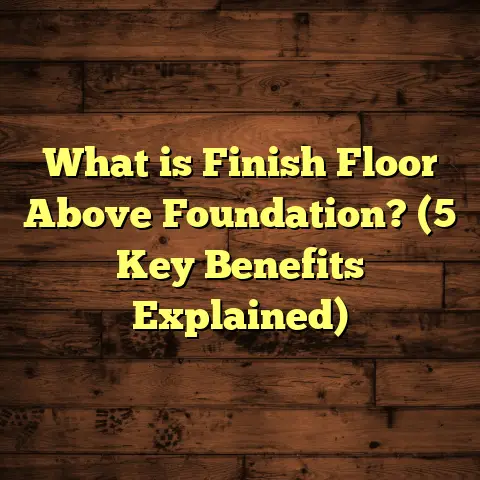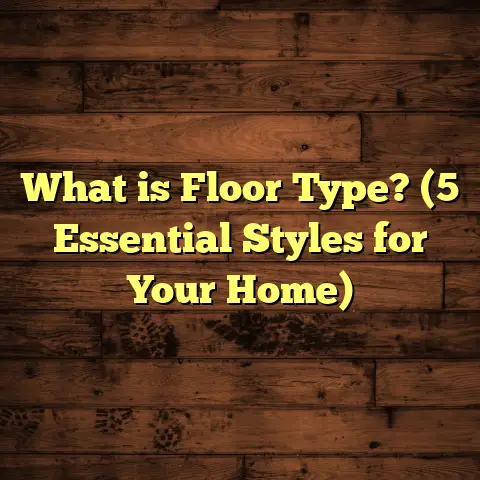What is Vitrified Flooring? (5 Benefits for Modern Homes)
Have you ever noticed floors that look sleek, glossy, and just seem to last forever without losing their charm? Maybe you’ve visited a friend’s house or a showroom and wondered how their floors remain so pristine despite heavy usage. I’ve met many homeowners who share this curiosity—and over the years, I’ve found that vitrified flooring often plays a starring role in those spaces. It’s one of those materials that quietly combines practicality and beauty in a way that’s hard to beat.
I still remember the first time I worked with vitrified tiles. It was on a renovation project for a young couple who wanted a modern look for their new home but worried about durability and upkeep. I showed them what vitrified flooring could offer—hardness, water resistance, low maintenance—and they were sold. Since then, I’ve installed countless vitrified floors and learned everything from the science behind these tiles to the best tricks for making them last decades.
Let me walk you through everything I know about vitrified flooring—what it is, why it’s great for modern homes, how to install and maintain it properly, and some insider tips from my personal experiences. You’ll also get a sense of how it compares to other flooring options and why it might be the perfect choice for your next home project.
What Is Vitrified Flooring? The Science Behind the Gloss
When people ask me about vitrified flooring, I like to break it down simply: vitrified tiles are basically ceramic tiles made by fusing raw materials like clay, quartz, silica, and feldspar at extremely high temperatures. This process creates a tile that’s dense and glass-like on the surface—hence the word “vitrified,” which comes from “vitrify,” meaning to turn into glass.
Here’s why that matters:
- Low Porosity: Because of the fusion process, vitrified tiles have almost zero porosity (water absorption less than 0.05%). This means they don’t soak up water or stains.
- Hardness: These tiles rank high on the Mohs scale of hardness—usually around 7 or above—making them resistant to scratches and wear.
- Strength: The fusion also makes them stronger than regular ceramic tiles, so they’re less likely to crack under pressure.
- Surface Finish: They come in different finishes from glossy to matte, with some looking strikingly like natural stones such as marble or granite.
Types of Vitrified Tiles
Knowing which type suits your needs is key. There are mainly three types:
- Soluble Salt Vitrified Tiles:
These have a glazed surface with printed patterns. They’re popular for decorative purposes but can be slightly less durable than other types. - Double Charge Vitrified Tiles:
Made by pressing two layers—the base tile and a pigmented layer—these are thicker and more suitable for heavy traffic. - Full Body Vitrified Tiles:
The color and texture run through the entire tile thickness. Scratches don’t show easily because the tile’s body looks uniform. These are the most durable type and ideal for high-use areas.
Why Do I Recommend Vitrified Flooring for Modern Homes?
Over many years of installing floors in residential and commercial settings, I’ve seen vitrified flooring become increasingly popular—and for good reasons. Here are five benefits I always highlight when talking to homeowners:
1. Durability That Stands the Test of Time
You want floors that can handle everyday life without constant repairs or refinishing, right? Vitrified tiles are exceptionally tough. The hardness rating (7+ on Mohs scale) means they resist scratches from furniture, pet claws, or dropped objects better than hardwood or laminate.
For example, a client of mine who runs a daycare center chose full body vitrified tiles because of the heavy foot traffic and constant movement of toys and furniture. Even after three years, the floor looks nearly untouched.
According to data from the Tile Council of North America (TCNA), vitrified tiles can last 20–30 years or more with proper care—much longer than vinyl or laminate options.
2. Water Resistance Makes Them Ideal for Wet Areas
Bathrooms, kitchens, laundry rooms—they all face moisture challenges. The near-zero water absorption rate of vitrified tiles means spills won’t seep in and cause damage like warping or mold growth.
In one coastal home renovation I managed, where humidity was a serious concern, installing vitrified flooring saved the homeowner hundreds in future repair costs they might have faced with wood or laminate floors.
3. Style Without Sacrificing Practicality
Vitrified tiles come in an impressive range of designs and finishes. If you love the look of marble but dread the maintenance and price tag, full body vitrified tiles can give you the aesthetic you want at a fraction of the cost.
I recently helped a client create a modern kitchen with large-format glossy vitrified tiles that imitated polished granite—without worrying about stains or etching from acidic spills.
4. Maintenance Is Straightforward
One thing homeowners tell me again and again: “I love how easy it is to clean these floors.” Unlike carpet that traps dust or hardwood that needs refinishing every few years, vitrified floors only require simple sweeping and mopping.
Using mild detergent or tile cleaners keeps them looking great without special treatments or waxing.
5. Cost-Effective Over the Long Run
Initial costs can vary depending on tile type and size but generally fall between $5 to $15 per square foot installed. This is higher than vinyl or laminate but less than premium hardwood or natural stone.
When you factor in longevity, low maintenance costs, and resistance to damage, vitrified tiles often prove more economical over 10+ years.
How Does Vitrified Flooring Compare with Other Flooring Options?
I get asked all the time: “How does vitrified flooring stack up against hardwood, laminate, or vinyl?” Here’s my take based on hands-on experience:
| Flooring Type | Durability | Water Resistance | Maintenance | Cost Range (Installed) | Aesthetic Options |
|---|---|---|---|---|---|
| Vitrified Tiles | Very High | Very High | Low | $5–$15 / sq ft | Wide variety; marble/stone looks |
| Hardwood | Moderate | Low | High | $8–$20 / sq ft | Natural wood grains & finishes |
| Laminate | Moderate | Low-Medium | Moderate | $3–$8 / sq ft | Wood/stone imitations; limited texture |
| Vinyl | Low-Moderate | High | Low | $2–$7 / sq ft | Many colors/patterns but flat finish |
| Natural Stone | Very High | High | Moderate | $10–$25 / sq ft | Unique natural patterns; expensive |
If durability and water resistance are priorities (especially with kids/pets), vitrified flooring often beats laminate and hardwood hands down.
Installation: What You Need to Know Before You Start
Installing vitrified flooring isn’t complicated but requires precision. Here’s my step-by-step guide based on years of installations:
Step 1: Prepare the Subfloor Properly
Vitrified tiles are rigid and brittle compared to wood or vinyl planks. If your subfloor isn’t perfectly flat and stable, cracks may develop over time.
- Clean thoroughly.
- Level uneven spots using self-leveling compound.
- Repair cracks or holes.
- Ensure dryness because moisture can cause adhesion problems.
This prep work usually takes longer than laying tiles but pays off by preventing costly repairs later.
Step 2: Plan Your Layout
Before you start sticking tiles down:
- Measure your room accurately.
- Plan tile placement to minimize cuts.
- Decide grout line width (usually 2–3 mm).
- Dry lay a few rows to visualize.
Proper layout helps avoid awkward patterns near walls or doors.
Step 3: Choose the Right Adhesive
Not all adhesives are created equal for vitrified tiles because of their low porosity.
- Use polymer-modified cement-based adhesives designed for vitrified surfaces.
- Follow manufacturer guidelines for mixing ratios.
- Avoid quick-dry adhesives unless experienced.
Good adhesion prevents loosening or tile lifting later.
Step 4: Begin Tiling
- Spread adhesive evenly using a notched trowel.
- Place tiles carefully; press firmly.
- Use spacers for consistent grout lines.
- Cut tiles using a wet saw for clean edges.
Step 5: Grouting
After adhesive dries (usually 24 hours):
- Mix grout (cement-based or epoxy).
- Apply evenly using rubber float.
- Clean excess grout promptly before it hardens.
- Seal grout lines if recommended.
Step 6: Curing
Avoid foot traffic for at least 24–48 hours after grouting so everything bonds firmly.
How I Maintain Vitrified Floors in My Projects
Years back, I worked on a home where the client wanted floors that would survive their busy daily life with minimal fuss. We went with vitrified tiles for their living areas. Here’s how I recommended they keep those floors shining:
- Sweep daily to remove grit that can scratch.
- Mop weekly using warm water mixed with mild detergent.
- Avoid acidic or abrasive cleaners—vinegar or bleach can dull finishes.
- Place mats at entryways to catch dirt.
- Wipe spills immediately to prevent stains (though rare).
I check back with many clients years later—they’re always happy because these simple routines keep floors looking new without expensive polishing or repairs.
Unique Insights from My Projects
Over time, I noticed some patterns that aren’t always obvious in brochures:
Thermal Comfort Benefits
In several projects located in hot climates, homeowners reported cooler indoor temperatures after switching to vitrified tiles compared to carpets or wood floors. This is because tiles conduct heat away efficiently—a natural way to keep rooms comfortable without overreliance on air conditioning.
Impact on Indoor Air Quality
Unlike carpets that trap dust mites and allergens, vitrified floors don’t harbor such irritants. For clients with allergies or asthma, this is a big plus.
Eco-Friendly Manufacturing Trends
Some brands now produce vitrified tiles with recycled materials and energy-efficient kilns. I’ve worked with suppliers who provide certifications showing reduced carbon footprints—a great match for sustainable building goals.
Data & Statistics That Back Up Vitrified Flooring’s Popularity
To put this all in perspective:
- The global market for vitrified tiles is expected to grow at a CAGR (Compound Annual Growth Rate) of about 6% between 2023–2030 (Source: Market Research Future).
- A survey by Construction Market Analysts found that over 60% of homeowners replacing floors choose vitrified tiles for their combination of durability and design options.
- According to ASTM testing standards (American Society for Testing Materials), vitrified tiles meet stringent criteria for abrasion resistance (Class III – Heavy commercial use), making them suitable even for offices and retail spaces—not just homes.
Case Study #1: Urban Loft Transformation
A client approached me wanting durable floors that would suit their open-concept loft with industrial chic decor. We picked large-format double charge vitrified tiles in matte charcoal gray.
The installation took four days for about 1,200 sq ft including kitchen and living areas. After eight months living there, they reported zero cracks or stains despite hosting frequent parties.
Their favorite part? The subtle texture gave grip underfoot—no slipping even when wet—but still looked sleek enough for their modern aesthetic.
Case Study #2: Family Home Makeover
The Johnson family had children under age 10 and two dogs. Their old carpet was stained constantly and hardwood scratched easily from pet claws.
We replaced it with full body vitrified tiles resembling warm oak wood grain. The family loved how easy cleanup was after spills and how the floor stayed scratch-free despite pets running around.
After two years, they said their floors looked better than when installed—a testament to durability in a real-life scenario.
Design Ideas Using Vitrified Flooring
Thinking about design? Here’s what I’ve seen work well:
Large Format Tiles for Spacious Feel
Using big tiles (24″x24″ or larger) reduces grout lines creating an almost seamless look—perfect for modern minimalistic interiors.
Mixing Finishes
Pairing matte tiles in living areas with glossy ones in bathrooms adds subtle contrast without clashing styles.
Pattern Play
Herringbone or chevron layouts with rectangular vitrified tiles add visual interest beyond simple grid patterns.
Border Accents
Using different colored tiles as borders can frame rooms beautifully—a little detail that elevates space subtly but effectively.
Troubleshooting Common Issues & How I Handle Them
Sometimes things don’t go perfectly—here are common problems I’ve tackled:
Cracked Tiles After Installation
Usually caused by uneven subfloors or poor adhesive quality. Solution: Remove cracked tile carefully; level subfloor; reapply correct adhesive; replace tile.
Grout Discoloration
Can happen if grout isn’t sealed properly or harsh cleaners are used. Solution: Clean grout lines; apply grout sealer; switch to pH-neutral cleaning products.
Slippery Floors When Wet
Glossy vitrified tiles can be slippery if not textured properly. Solution: Choose matte finish or add anti-slip coatings in wet areas like bathrooms/kitchens.
I hope this deep look into vitrified flooring gives you clear insight into why I trust this material so much for modern homes. It balances toughness and style like few others can—and when installed right, it lasts long enough to become part of your family’s story.
Feel free to ask me anything about costs, installation timelines, or design ideas tailored specifically to your home—I’m always here to help!





